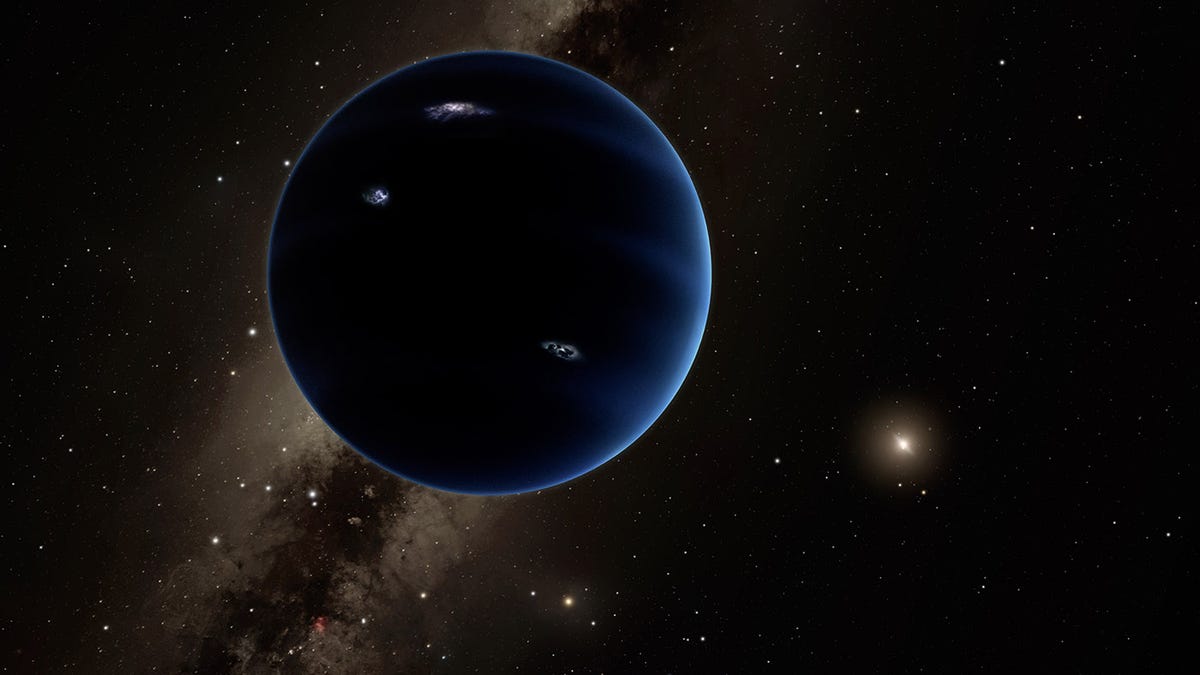The solar system's hidden Planet X may finally be spotted soon
A new paper suggests the hidden world known as Planet X is closer to being seen than previously thought.

An artist's rendition of Planet X.
Astronomers who suspect a hidden planet known as "Planet X" or "Planet Nine" is affecting the comings and goings of icy objects beyond Neptune, say we could soon lay eyes on the distant, mysterious world.
In a 92-page paper to be published in Physics Reports, a team of researchers at Caltech review the evidence for Planet X's existence and describe a world that is closer and smaller than previously thought.
Almost a decade after poor Pluto was demoted from the ninth planet to just another of many dwarf planets, an intriguing paper was published by one of the "Pluto-killing" astronomers and his former student. The hypothesis suggested a larger, unseen Planet X lurks even further out on the edge of our solar system.
"In essence, three years ago, we knew that the orbits of very distant Kuiper belt objects were clustered together," Konstantin Batygin, the junior half of the duo, told me in an email Tuesday. "And we could demonstrate with the aid of computer simulations that the only sensible reason for this clustering was the existence of Planet Nine."
The idea is that the distant objects Batygin mentions are being influenced by the gravitational pull of a large planet orbiting somewhere in the solar system's outfield.
Now CalTech's Batygin, his former mentor Michael Brown (aka "PlutoKiller" on social media) and colleagues Fred Brown and Juliette Becker from the University of Michigan have an update for us. And if their theory holds water, it would radically redefine how we envision our solar system.
"Our new efforts, both theoretical and numerical, suggest that in the original paper we over-estimated the parameters of Planet Nine," Batygin explained.
The new analysis paints a picture of a planet with a mass five times more than Earth's and which is located about 400 astronomical units (AU) away. For comparison, Pluto is only about 40 AU from us. The authors also conclude that the unseen planet is likely to be a rocky super-Earth rather than a gas giant. But the prospects for habitability are of course quite dim, just as the sun would be at such a distance.
"Although this analysis does not say anything directly about whether Planet Nine is there, it does indicate that the hypothesis rests upon a solid foundation," said Brown, a professor of planetary astronomy at Caltech, in a release.
The paper also seeks to address some of the criticisms of the Planet Nine hypothesis and alternate explanations for the weirdness observed in the Kuiper Belt. For example, Batygin and colleagues are not convinced by a competing theory that says a massive disk of debris beyond Neptune could explain the weird orbits of distant Kuiper Belt objects as well as an unseen super-Earth.
"The strongest argument in favor of Planet Nine is that independent lines of evidence can all be explained by a proposed new planet with the same properties. In other words, there are multiple reasons to believe that Planet Nine is real, not just one," said co-author Fred Adams.
If Planet X does exist and is as this latest paper describes it, it will also be a key missing piece to our solar system.
As the catalog of known exoplanets around other stars has rapidly expanded over the past decade, it has become increasingly clear that our system is actually pretty unusual. That's because rocky super-earths appear to be very common elsewhere, yet there isn't one in our solar system.
"Planet Nine is going to be the closest thing we will find to a window into the properties of a typical planet of our galaxy," Batygin explained.
But he concedes that all the speculation around Planet X will remain just that until someone finally spots it.
"The prospect of one day seeing real images of Planet Nine is absolutely electrifying," he says. "Although finding Planet Nine astronomically is a great challenge, I'm very optimistic that we will image it within the next decade."

